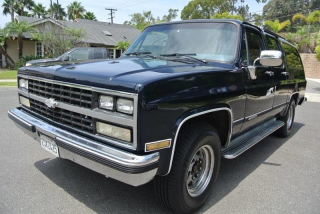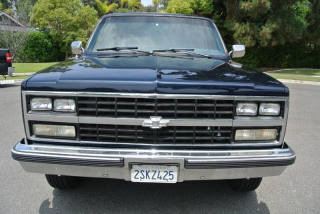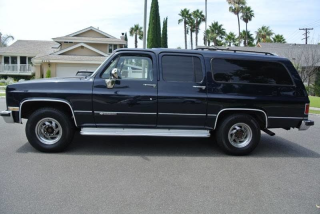The Good
The 1990 Suburban's advantages include its legendary durability and powerful V8 engine options, offering dependable performance for heavy loads and long hauls. Its cavernous interior provides impressive comfort and versatility for large families, appealing to the practical buyer. Emotionally, its classic, rugged design evokes a sense of adventure and enduring American strength, making it a valuable, timeless choice.
The Bad
Known weaknesses for the 1990 Suburban include its notoriously poor fuel economy, especially with the larger engines. Rust is a common issue, particularly around wheel wells, rocker panels, and tailgates. Buyers should also watch out for potential transmission problems, worn suspension components, and electrical glitches typical of older vehicles, requiring diligent maintenance.
1990 Chevrolet Suburban: Quick Overview
- Engine Options:
The 1990 Chevrolet Suburban offered several robust V8 engine choices suitable for its heavy-duty nature.- 5.7L (350 cu in) V8 (LO5 TBI): This was the most common gasoline engine, offering a balance of power and relative efficiency.
- 7.4L (454 cu in) V8 (L19 TBI): A powerful big-block option, designed for maximum towing and hauling capabilities, typically found in 2500-series models.
- 6.2L (379 cu in) V8 Diesel (Detroit Diesel): An option for those prioritizing fuel economy and low-end torque, though less powerful than the gasoline engines.
- Horsepower:
- 5.7L V8: Approximately 190-210 horsepower.
- 7.4L V8: Around 230-250 horsepower.
- 6.2L Diesel V8: Roughly 130-160 horsepower.
- Fuel Economy (Estimated):
Fuel economy for these large SUVs was not a strong suit.- 5.7L V8: Around 10-14 MPG combined.
- 7.4L V8: Typically 8-12 MPG combined.
- 6.2L Diesel V8: Potentially 15-20 MPG combined, making it the most economical choice.
- 0-60 MPH Times:
Performance was not geared towards acceleration.- Expect 0-60 mph times in the 10-12 second range for the 5.7L V8, and slightly slower for the 6.2L Diesel, with the 7.4L V8 being the quickest. These are estimates, as official figures were rarely emphasized for utility vehicles.
- Towing Capacity:
A major selling point for the Suburban.- Depending on the engine, drivetrain (2WD/4WD), and axle ratio, towing capacity ranged significantly.
- 5.7L V8: Could tow between 6,000 to 8,000 pounds.
- 7.4L V8: Capable of towing up to 10,000 pounds or more in properly equipped 2500 series models.
- Trim-Level Features:
The 1990 Suburban offered several trims, each building on the previous.- Scottsdale (Base): Basic vinyl or cloth seating, manual windows and locks, essential instrumentation.
- Cheyenne (Mid-level): Added some convenience features over the Scottsdale, potentially including better cloth upholstery, air conditioning (often optional), and AM/FM radio.
- Silverado (Top-level): Featured plush cloth or optional leather seating, power windows and door locks, cruise control, tilt steering wheel, upgraded audio systems (cassette or CD players were optional), more extensive chrome trim, and often two-tone paint schemes. Air conditioning and rear heat were common options.
1990 Chevrolet Suburban Specifications
Vehicle Information
| Year | 1990 |
| Make | Chevrolet |
| Model | Suburban |
| Trim | - |
| Style | - |
| Type | Sport Utility Vehicle |
| Category | Standard Sport Utility Vehicle |
Manufacturing Details
| Made In | United States |
| Manufacturing City | FLINT |
Dimensions
| Doors | 4-Door |
| Curb Weight | - |
| Gross Vehicle Weight Rating | 6100 pounds |
| Overall Height | - |
| Overall Length | - |
| Overall Width | - |
| Wheelbase Length | - |
| Standard Seating | - |
Engine & Performance
| Engine | 5.7-L V-8 OHV 16V |
| Engine Size | 5.7L |
| Engine Cylinders | 8 |
| Transmission | - |
| Transmission Type | Automatic |
| Transmission Speeds | - |
| Drivetrain | Four-Wheel Drive |
Additional Features
| Anti-Brake System | - |
| Steering Type | - |
Pricing
| Manufacturer Suggested Retail Price (MSRP) | - |
| Invoice Price | - |
| Delivery Charges | - |
Vehicle History Report
Specifications
History
Events
History Check
Check
Check
Check
Check
Listings
Recalls
Check
Analysis
What Problems Does the 1990 Chevrolet Suburban Have?
Transmission issues are also frequently cited, particularly with the 700R4 (later 4L60) automatic transmission. Overheating and delayed shifts can lead to premature failure, especially under heavy towing conditions without proper maintenance or an auxiliary cooler. The TH400/3L80 found with the 7.4L V8 is generally more robust but can still experience wear.
Electrical problems can manifest as faulty gauges, inoperative power windows/locks, or intermittent lighting issues, often due to aging wiring or poor grounds. The fuel gauge sender unit is a common failure point, leading to inaccurate readings. Engine-related concerns include oil leaks from the rear main seal or valve covers, and issues with the Throttle Body Injection (TBI) system, though generally reliable, can sometimes lead to rough idles or fuel delivery problems.
Brake system components, such as master cylinders and brake lines, can degrade over time, leading to spongy pedals or leaks. Steering components, including the steering box and tie rods, are prone to wear, resulting in loose steering feel. Suspension components, particularly bushings and ball joints, will require replacement due to age and vehicle weight.
Regarding recalls, information for a specific 1990 model year can be challenging to find definitively without a VIN, as many older recalls are addressed during service or forgotten. However, the GMT400 platform did have some recalls related to wiring harnesses, seat belt components, and brake systems throughout its production run. For instance, there were general recalls on GM trucks and SUVs around that period concerning potential fuel line leaks or cruise control module wiring issues. Prospective owners should always check with NHTSA or a GM dealership using the specific VIN for any outstanding recalls.
How long will the 1990 Chevrolet Suburban last?
However, neglect rapidly diminishes this longevity. Weaknesses that emerge over time include rust perforation, especially in northern climates. Transmissions can fail if fluid changes are ignored, and engine gaskets may leak with age. Suspension and steering components will inevitably wear out, requiring replacement for safe operation. Electrical issues, while often minor, can become frustrating without diagnosis. Consistent fluid changes, rust prevention, and addressing minor issues promptly are crucial for extending its service life.
What Technology & Safety Features are Included?
Built-in Tech & Convenience:
Basic instrumentation was standard, including a speedometer, odometer, fuel gauge, oil pressure gauge, coolant temperature gauge, and voltmeter. Optional convenience features, especially on higher Silverado trims, included power windows, power door locks, cruise control, and a tilt steering wheel. Air conditioning was a popular and often necessary option, especially with the large cabin volume. Rear heating was also an available option to keep back passengers comfortable. A relatively novel feature for the time was the optional "comfortilt" steering column.
Entertainment:
Entertainment options were basic by today's standards. A simple AM/FM radio was standard on most models. Upgrades included an AM/FM stereo with a cassette player, and on higher trims, a premium sound system with a cassette deck. A factory-installed CD player was a relatively rare and high-end option for a truck of this vintage, usually found only on the top Silverado trim.
Driver-Assistance & Safety Features:
Driver-assistance technology was virtually non-existent in the modern sense. Features like blind-spot monitoring, lane-keeping assist, or adaptive cruise control were decades away. The primary safety features were passive. For 1990, anti-lock brakes (ABS) for the rear wheels were generally standard on 1500 and 2500 series models, primarily to prevent rear-wheel lock-up during hard braking or when towing. Front airbags were not standard and generally not available in the 1990 Suburban; safety primarily relied on a robust steel frame, seatbelts (lap and shoulder belts for front occupants, lap belts for most rear occupants), and crumple zones.
Crash-Test Ratings:
Modern, standardized crash-test ratings (like those from NHTSA or IIHS) were not conducted on vehicles of this vintage. Therefore, specific, comparable crash-test ratings for the 1990 Chevrolet Suburban are not available. Its safety performance would be significantly lower than modern vehicles due to the absence of advanced restraint systems, multiple airbags, and sophisticated structural designs for impact energy absorption.
What Colors Options are Available?
1990 Chevrolet Suburban Prices and Market Value
In today's used market, prices vary wildly. A rust-free, well-maintained example, especially a 4x4, can fetch anywhere from $10,000 to $25,000+, reflecting a growing appreciation for classic "square body" trucks. Conversely, high-mileage, neglected, or heavily rusted examples might only command $2,000 to $7,000. Depreciation insights are interesting; after initial steep depreciation, these models have begun to appreciate, transitioning from merely "old" to "classic." Factors affecting resale value include overall condition, lack of rust, 4WD capability, engine choice (7.4L V8s and solid 5.7L are sought after), mileage, and maintenance history.
1990 Chevrolet Suburban Cost of Ownership
1990 Chevrolet Suburban Fuel Efficiency
1990 Chevrolet Suburban Safety Rating
NHTSA
IIHS
1990 Chevrolet Suburban Warranty
Basic
Powertrain
Rust
1990 Chevrolet Suburban Insurance
reasonable repair costs.
How Does the 1990 Chevrolet Suburban Compare to Other Sport Utility Vehicle?
In terms of performance, the 1990 Suburban's range of V8 engines (5.7L, 7.4L) generally offered superior towing and hauling capability compared to most civilian-oriented rival SUVs of the era, which often topped out with smaller V8s or inline-sixes. The Ford Bronco, while capable, was a two-door and offered slightly less interior volume and towing capacity. The Grand Wagoneer, while luxurious, typically had less powerful V8s and less overall utility.
Features were comparable; all offered basic power accessories, AC, and AM/FM radios. The Suburban's major advantage was its massive, three-row interior, which few rivals could match. The Grand Wagoneer offered more upscale, standard luxury features, but at a significantly higher price point.
Reliability for the 1990 Suburban is generally considered robust for its mechanical simplicity, sharing many parts with readily available GM trucks. Its rivals like the Bronco also enjoyed good reliability. The Grand Wagoneer, while iconic, often came with more complex electrical issues and specific AMC/Jeep parts that could be harder to source. However, the Suburban's rust issues are common across all '80s and '90s vehicles.
Price-wise, the Suburban was competitively priced for its utility. Used prices for well-preserved examples now often exceed their original MSRP, especially compared to a similarly aged Bronco, which can also command high prices due to its classic status.
Alternatives: For modern utility, a new or late-model large SUV like a Chevrolet Tahoe/Suburban, Ford Expedition, or GMC Yukon offers vastly superior safety, fuel economy, comfort, and tech. For a similar vintage "classic" experience with utility, a 1990s Ford F-series truck with a crew cab and camper shell provides comparable space and capability. A 1990s Ford Excursion (though later in the decade) would be a more direct competitor in terms of sheer size.
Final Verdict: Is the 1990 Chevrolet Suburban a Good Sport Utility Vehicle?
It can be worth buying if you find a well-preserved, rust-free example, ideally a K2500 (3/4-ton) 4x4 with the 7.4L V8 for heavy-duty work, or a C1500 (1/2-ton) with the 5.7L for more general use. It should be considered as a used vehicle, often a project or a lovingly maintained classic, not a daily driver expecting modern comforts or fuel efficiency. Buyers must factor in its poor fuel economy and the likelihood of age-related repairs. For the right owner, it's a durable, capable, and charismatic classic.


